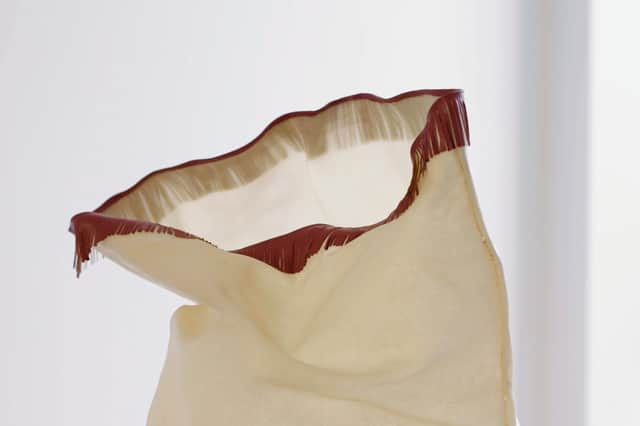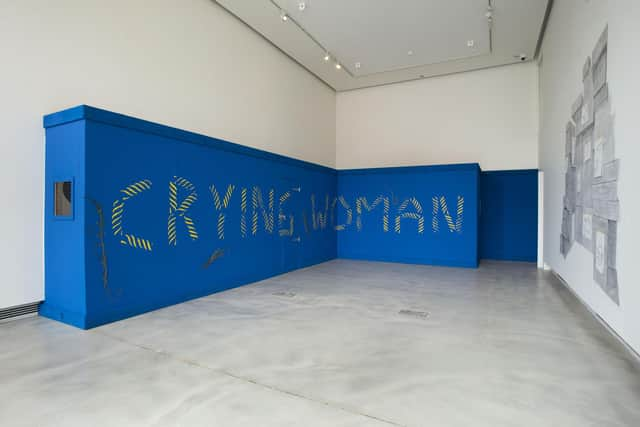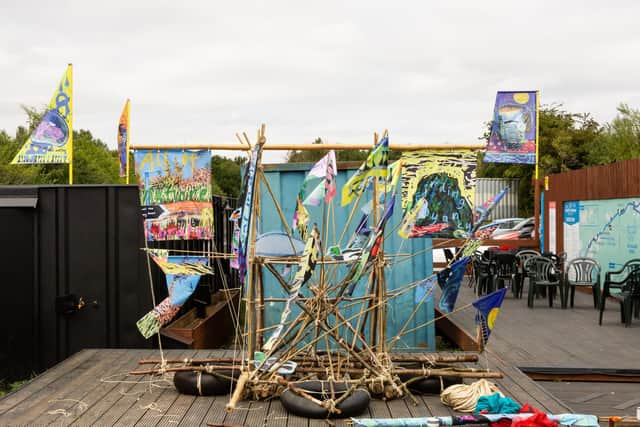Edinburgh Art Festival reviews: Nadia Myre | Tessa Lynch | Platform


Nadia Myre: Tell Me of Your Boats and Your Waters – Where Do The Come From, Where Do They Go? Edinburgh Printmakers ****
Tessa Lynch: Houses Fit For People, Edinburgh Printmakers ***
Platform: 2022, French Institute, Edinburgh ***
Advertisement
Hide AdThe Union Canal, connecting Edinburgh and Glasgow by water, opened in 1822, but it was in use industrially for just 20 years before the opening of the railway left it redundant. This year’s Edinburgh Art Festival commissions programme, The Wave of Translation, celebrate its 200th anniversary and its current regeneration after a long period of decline.
Canadian artist Nadia Myre, co-commissioned by EAF and Edinburgh Printmakers, focuses on the canal as a link between places, people and stories, in particular its role as a launch point for migrations to the New World: by barge to Glasgow, then on across the Atlantic. An immense warehouse for storing luggage once spanned its breadth.
Montreal-based Myre is a member of the Kitigan Zibi Anishinabeg First Nation, and brings that perspective to the canal’s colonial past. She discovered a book of First Nations folk tales by Scots emigré Dorothy Marion Reid published in 1963, four years after indigenous people were granted the vote, but when the policy of removing First Nations children from their homes and putting them into the welfare system was just beginning.
Text is important in her work, and the trickster character Nanabozho from Reid’s book finds their way into her excellent poems written for the Printmakers’ show, speaking elliptically to the history of the canal and the building. She also makes beautiful, sculptural vessels (luggage of a kind, perhaps) from deer hide. Another, more dreamy text sequence draws on a folk tale about a woman who falls in love with the moon, also used for her canalside installation between Edinburgh Printmakers and Lochrin Basin.


Meanwhile, in the larger gallery at Edinburgh Printmakers, Glasgow-based Tessa Lynch looks at spaces for living. In the archives of the North British Rubber Company, she found the plans to move the operation from Edinburgh to Dumfries in the 1950s, which included building housing for up to 8,000 workers. How exactly this work relates to these plans, however, or to the new apartment blocks springing up along the canal today, is less clear.
It’s not an easy exhibition to grasp, particularly as timber hoarding (with the puzzling title Crying Woman) on two sides of the gallery shuts out the viewer and conceals some of the work. Having spent lockdown working from her kitchen table while looking after her small daughter, Lynch incorporates childlike media – paper strips and patterns which look like glued down pasta.
Advertisement
Hide AdThe major print work is a collaged stack of cardboard boxes with line drawings of babies attached to it with masking tape. These confident graphic forms of small children making space for themselves are, perhaps, a statement and a question: they should not be boxed in, but what living spaces will exist for them to inhabit in the future?
Along the canal itself, EAF associate artist Emmie McLuskey curates Channels, a programme of site-specific outdoor works: two text billboards by Maeve Redmond commemorate the canal builders, both the engineers and the labourers; there are sound works under two bridges by Hannan Jones, and five plaques and a walking guide by Amanda Thomson, drawing both on the flora of the area and on its history. Choreographer Janice Parker will make the journey from Lochrin Basin to Wester Hailes daily from 14-28 August, responding to her surroundings in movement, and there is a temporary radio station, Background Noise, which operates on Saturdays.


Advertisement
Hide AdKeep walking west and you will reach Wester Hailes, the focus of engagement by EAF through lockdown and the site of two of this year’s invited artist commissions, working together with community arts organisation WHALE Arts. Coloured flags outside the Bridge 8 Hub and Paddle Cafe testify to the presence of Glasgow-based artists Ruby Pester and Nadia Rossi, working with members of the community to create the flags, to build a home-made raft and create a performance on a boat with the Rhubaba Choir.
Meanwhile, at the Westside Plaza shopping centre, a former off licence has been transformed into the Community Wellbeing Cooperative, a project initiated by Dutch artist Jeanne Van Heeswijk and developed with some 25 local people over the past nine months. The Art Festival is the public launch of the project – for daily events, workshops and activities see wwww.watchthisspace.online – and the aim is to continue long-term. The focus ranges from mindfulness workshops to discussions on more political topics like housing.
EAF’s Platform programme, at the French Institute, supports four selected emerging artists, all graduates from Scottish art schools in the last five years, to make new work. Emelia Kerr Beale focuses on the Major Oak, the tree near Nottingham believed to be around 1,000 years old. Instead of letting the lower branches droop to the ground to help support its weight, well-meaning people, over the years, have created a metal scaffold for it, on which the tree now relies. For Beale, this becomes a metaphor for how those with illness or disability are not treated as the experts in their own experience. A beautiful film of the tree shows up the ugliness and artificiality of the scaffold, while a series of knitted sweaters, joined at the arms, suggest a form of solidarity putting forward a different approach.
Saoirse Amira Anis’ work is substantial too. She has made a series of dyes from natural edible ingredients found in her two native countries, Scotland and Morocco. As well as a curtain of delicately tinted fabrics, there is a film which shows her process, getting her hands dirty in a time-consuming act of creation which, her poetic text suggests, is also a metaphorical labour of love.
Lynsey MacKenzie is an abstract painter who has developed a distinctive style. Working on large and small scales, she is interested in colour and texture and how paintings can build up in a non-linear way, one becoming the source for the next. Her two-room installation looks strong against lime green walls. Jonny Walker creates a sound installation and sculptures of lambs in various stages of erosion and collapse. This work is the most puzzling of the four; a creature already weighted down with symbolic value seems a strange choice for a work which claims to be about growth and decay more generally.
Nadia Myre and Tessa Lynch both run until 18 September; Platform until 28 August. For information on the other EAF commissioned artworks and events, visit www.edinburghartfestival.com and www.watchthisspace.online